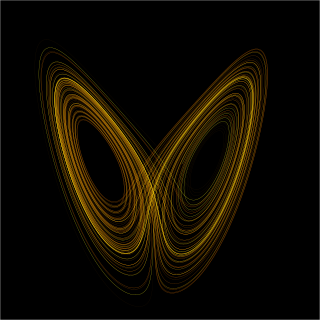
Nonlinear functional analysis is a branch of mathematical analysis that deals with nonlinear [ disambiguation needed ] mappings.

Nonlinear functional analysis is a branch of mathematical analysis that deals with nonlinear [ disambiguation needed ] mappings.
Its subject matter includes: [1] : 1–2

In mathematics, a dynamical system is a system in which a function describes the time dependence of a point in an ambient space, such as in a parametric curve. Examples include the mathematical models that describe the swinging of a clock pendulum, the flow of water in a pipe, the random motion of particles in the air, and the number of fish each springtime in a lake. The most general definition unifies several concepts in mathematics such as ordinary differential equations and ergodic theory by allowing different choices of the space and how time is measured. Time can be measured by integers, by real or complex numbers or can be a more general algebraic object, losing the memory of its physical origin, and the space may be a manifold or simply a set, without the need of a smooth space-time structure defined on it.

Functional analysis is a branch of mathematical analysis, the core of which is formed by the study of vector spaces endowed with some kind of limit-related structure and the linear functions defined on these spaces and suitably respecting these structures. The historical roots of functional analysis lie in the study of spaces of functions and the formulation of properties of transformations of functions such as the Fourier transform as transformations defining, for example, continuous or unitary operators between function spaces. This point of view turned out to be particularly useful for the study of differential and integral equations.

In mathematics, a fixed point, also known as an invariant point, is a value that does not change under a given transformation. Specifically, for functions, a fixed point is an element that is mapped to itself by the function.
The Schauder fixed-point theorem is an extension of the Brouwer fixed-point theorem to topological vector spaces, which may be of infinite dimension. It asserts that if is a nonempty convex closed subset of a Hausdorff topological vector space and is a continuous mapping of into itself such that is contained in a compact subset of , then has a fixed point.
In mathematics, operator theory is the study of linear operators on function spaces, beginning with differential operators and integral operators. The operators may be presented abstractly by their characteristics, such as bounded linear operators or closed operators, and consideration may be given to nonlinear operators. The study, which depends heavily on the topology of function spaces, is a branch of functional analysis.
In mathematics, a fixed-point theorem is a result saying that a function F will have at least one fixed point (a point x for which F(x) = x), under some conditions on F that can be stated in general terms.
In mathematics, infinite-dimensional holomorphy is a branch of functional analysis. It is concerned with generalizations of the concept of holomorphic function to functions defined and taking values in complex Banach spaces, typically of infinite dimension. It is one aspect of nonlinear functional analysis.

Louis Nirenberg was a Canadian-American mathematician, considered one of the most outstanding mathematicians of the 20th century.

Shizuo Kakutani was a Japanese and American mathematician, best known for his eponymous fixed-point theorem.
In mathematical analysis, the Kakutani fixed-point theorem is a fixed-point theorem for set-valued functions. It provides sufficient conditions for a set-valued function defined on a convex, compact subset of a Euclidean space to have a fixed point, i.e. a point which is mapped to a set containing it. The Kakutani fixed point theorem is a generalization of the Brouwer fixed point theorem. The Brouwer fixed point theorem is a fundamental result in topology which proves the existence of fixed points for continuous functions defined on compact, convex subsets of Euclidean spaces. Kakutani's theorem extends this to set-valued functions.

Mark Aleksandrovich Krasnoselsky was a Soviet and Russian mathematician renowned for his work on nonlinear functional analysis and its applications.
In numerical analysis, fixed-point iteration is a method of computing fixed points of a function.
Numerical continuation is a method of computing approximate solutions of a system of parameterized nonlinear equations,
William Arthur ("Art") Kirk was an American mathematician. His research interests include nonlinear functional analysis, the geometry of Banach spaces and metric spaces. In particular, he has made notable contributions to the fixed point theory of metric spaces; for example, he is one of the two namesakes of the Caristi-Kirk fixed point theorem of 1976. He is also known for the Kirk theorem of 1964.

A set-valued function is a mathematical function that maps elements from one set, the domain of the function, to subsets of another set. Set-valued functions are used in a variety of mathematical fields, including optimization, control theory and game theory.
A classical problem of Stanislaw Ulam in the theory of functional equations is the following: When is it true that a function which approximately satisfies a functional equation E must be close to an exact solution of E? In 1941, Donald H. Hyers gave a partial affirmative answer to this question in the context of Banach spaces. This was the first significant breakthrough and a step towards more studies in this domain of research. Since then, a large number of papers have been published in connection with various generalizations of Ulam's problem and Hyers' theorem. In 1978, Themistocles M. Rassias succeeded in extending the Hyers' theorem by considering an unbounded Cauchy difference. He was the first to prove the stability of the linear mapping in Banach spaces. In 1950, T. Aoki had provided a proof of a special case of the Rassias' result when the given function is additive. For an extensive presentation of the stability of functional equations in the context of Ulam's problem, the interested reader is referred to the recent book of S.-M. Jung, published by Springer, New York, 2011.

Robert Ralph Phelps was an American mathematician who was known for his contributions to analysis, particularly to functional analysis and measure theory. He was a professor of mathematics at the University of Washington from 1962 until his death.
Roger David Nussbaum is an American mathematician, specializing in nonlinear functional analysis and differential equations.